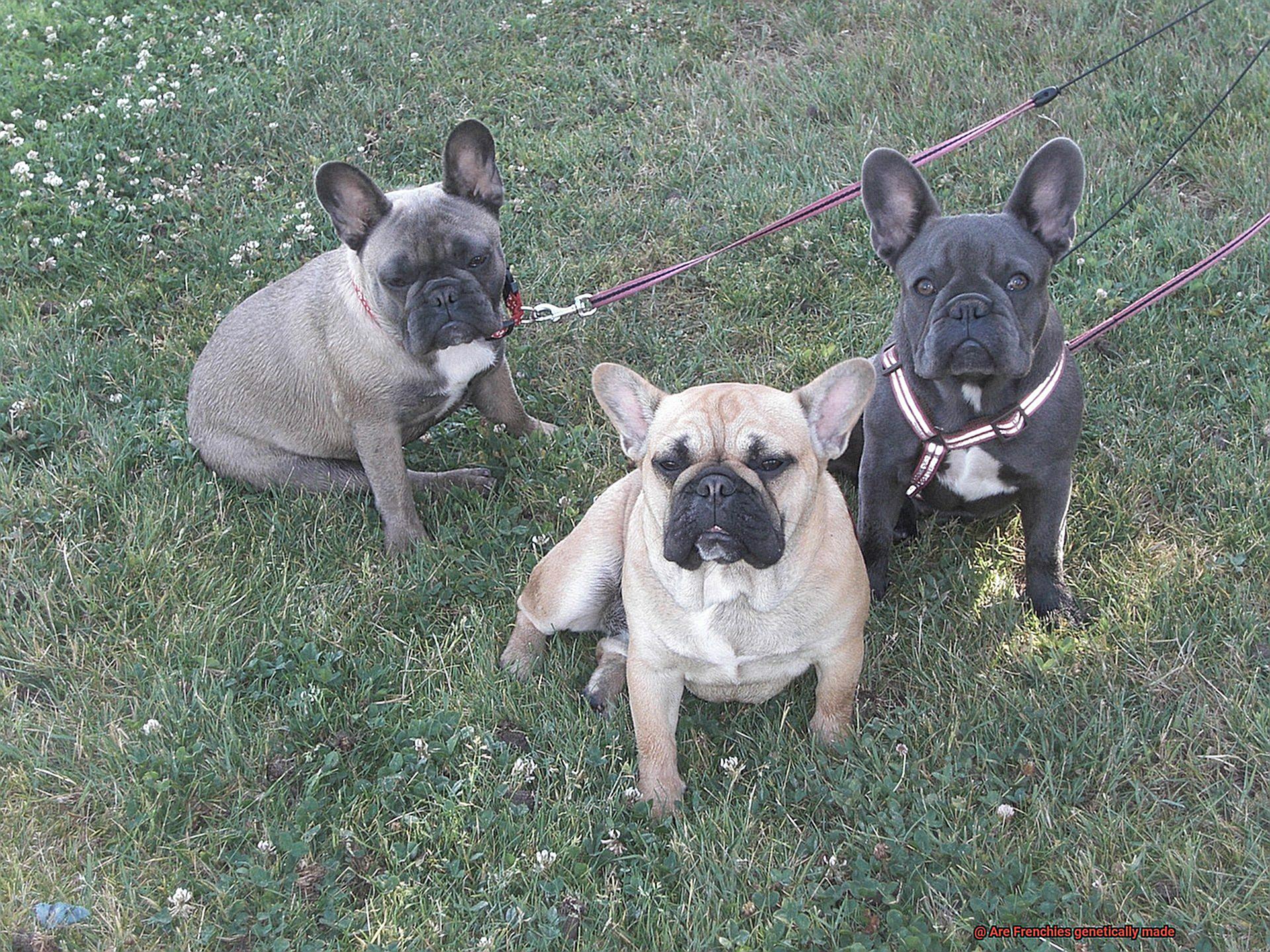Are Frenchies genetically made?
Welcome to our blog, where we embark on an exhilarating quest to uncover the genetic blueprint of one of the most adored dog breeds worldwide – the French Bulldog. With their irresistible charm, distinctive appearance, and captivating personalities, Frenchies have skyrocketed in popularity in recent times. However, amidst all the love and admiration, a burning question lingers: were these adorable creatures truly “genetically made”?
In this article, we dive headfirst into the mesmerizing realm of genetics to shed light on the origins and genetic characteristics that define this extraordinary breed. By unraveling the genetic makeup of French Bulldogs, we aim to debunk any misconceptions surrounding their creation while offering you a deeper understanding and admiration for these delightful companions.
So, without further ado, let’s embark on an enthralling journey that unveils the genetic secrets behind those iconic bat-ears, robust physique, and lovable temperament that make French Bulldogs so incredibly special.

The Origins of French Bulldogs
Contents
- 1 The Origins of French Bulldogs
- 2 Selective Breeding and French Bulldog Traits
- 3 Potential Health Issues for French Bulldogs
- 4 Genetics and the Role They Play in Frenchie’s Physical Characteristics
- 5 Natural Variation in Frenchie Genetics
- 6 Extreme Breeding Practices and Their Impact on French Bulldogs’ Well-Being
- 7 Responsible Breeding Practices for Improving Frenchie Health
- 8 Conclusion
French Bulldogs, also known as Frenchies, are one of the most popular dog breeds today. With their adorable bat-like ears and expressive faces, it’s no wonder they’ve stolen the hearts of dog lovers worldwide. But have you ever wondered where these lovable pups come from? In this blog post, we’ll dive into the origins of French Bulldogs and how their physical characteristics have evolved over time.
Lace Workers’ Best Friend
In the 1800s, French Bulldogs were first bred in England as a smaller version of the English Bulldog. They were originally companions to lace workers who migrated from England to France during the Industrial Revolution. These lace workers brought their beloved Bulldogs with them, and soon these little dogs became a hit among the French.
A Blend of Breeds
Once in France, these smaller Bulldogs were crossed with local breeds like Terriers and Pugs. This crossbreeding resulted in the development of the French Bulldog we know and love today. The breed quickly gained popularity among both the working class and the upper class in France.
Evolution of Physical Characteristics
Over time, French Bulldogs underwent changes in their physical appearance. Initially, they had erect ears like their English Bulldog ancestors. However, breeders preferred dogs with bat-like ears instead, leading to the unique ear shape seen in modern Frenchies.
Another change was in size. Early French Bulldogs were larger than present-day Frenchies. Through selective breeding for smaller individuals within the breed, today’s French Bulldogs are compact and weigh between 16-28 pounds.
The Global Love for Frenchies
French Bulldogs may have originated in England and gained popularity in France, but they have become a beloved breed worldwide. Their distinctive appearance, friendly nature, and adaptability make them a perfect choice for families and individuals seeking a loyal companion.
Selective Breeding and French Bulldog Traits
French Bulldogs, or Frenchies, are known for their distinctive physical features and lovable personalities. These traits have been cultivated through selective breeding practices over the years. However, it is important to understand the potential health issues associated with these traits to ensure the well-being of your furry friend.
Selective Breeding for Physical Features:
- Compact and muscular body: French Bulldogs were bred to have a sturdy and compact build, making them ideal companions for city dwellers.
- “Bat-like” ears: These adorable ears are a result of selective breeding, adding to the breed’s charm and uniqueness.
- Short muzzle: The shortened muzzle is a defining feature of French Bulldogs, but it can lead to respiratory issues and difficulty regulating body temperature.
Selective Breeding for Temperament:
- Friendly and affectionate: French Bulldogs are known for their loving and sociable nature, making them great family pets.
- Playful and adaptable: They have a playful spirit and adapt well to various living environments, including apartments.
Potential Health Issues:
- Brachycephalic syndrome: The short muzzle can lead to breathing difficulties, especially in hot weather. It is crucial to monitor their breathing and keep them cool.
- Respiratory issues: French Bulldogs often have narrow air passages, making them prone to snoring, snorting, and wheezing.
- Skin allergies: Some Frenchies may develop skin allergies due to their sensitive skin. Regular grooming and a balanced diet can help manage these issues.
- Joint problems: The compact body structure can contribute to joint issues like hip dysplasia. Exercise moderation and weight management are essential.
Potential Health Issues for French Bulldogs
French Bulldogs, or Frenchies as they are affectionately called, are known for their adorable appearance and friendly disposition. However, these lovable little companions are not without their share of potential health issues. Here, we’ll explore some common health concerns that French Bulldog owners should be aware of, and how to navigate the French connection to keep your Frenchie in tip-top shape.
- Brachycephalic Airway Syndrome: The French Bulldog’s unique flat face and shortened nose can lead to breathing difficulties. Keep an eye out for noisy breathing, snoring, coughing, or even fainting or collapsing in severe cases. Regular veterinary check-ups and monitoring your Frenchie’s breathing patterns can help manage this condition.
- Allergies: French Bulldogs can be prone to skin allergies, food allergies, and environmental allergies. Look out for signs of itchiness, redness, rashes, diarrhea, or vomiting. Identifying and avoiding allergens through dietary changes, environmental modifications, or medications prescribed by a veterinarian can provide relief.
- Eye Problems: Cherry eye, corneal ulcers, cataracts, and progressive retinal atrophy (PRA) are some of the eye conditions that may affect French Bulldogs. Regular eye examinations by a veterinary ophthalmologist are essential for early detection and treatment.
- Skin Fold Dermatitis: The adorable wrinkles on a Frenchie’s face may require extra care. Moisture and debris can accumulate in these folds, leading to bacterial or yeast infections. Regular cleaning and drying of the skin folds using recommended products can help prevent infections.
- Orthopedic Problems: French Bulldogs are prone to hip dysplasia and intervertebral disc disease (IVDD). Maintaining a healthy weight, providing proper support for the back and joints, and regular exercise can help reduce the risk of these conditions.
Genetics and the Role They Play in Frenchie’s Physical Characteristics
When it comes to French Bulldogs, it’s not just their adorable wrinkly faces and perky ears that make them stand out from the pack. These lovable pups owe their unique physical characteristics to the fascinating world of genetics. So, grab a cup of coffee, find a cozy spot, and let’s dive into the genetic wonders behind our beloved Frenchies.
Coat Color Chronicles
French Bulldogs come in a delightful array of colors, like fawn, brindle, white, cream, and pied. But did you know that these color variations are determined by a colorful combination of genes? It’s true. The genes responsible for pigmentation in their fur create the perfect palette for our furry friends.
Body Structure Secrets
Have you ever noticed how Frenchies have a compact and muscular build? It’s like they were born to strut their stuff on the doggy runway. Well, that’s because specific genes control their bone development and muscle growth. These genetic wonders shape their square-shaped heads and stocky bodies, making them the heart-melting beauties we adore.
The Brachycephalic Brigade
Ah, the signature brachycephalic skull shape of French Bulldogs. You can’t help but fall head over paws for those adorable flat faces. This distinctive feature is caused by variations in genes that impact skull bone growth and facial structures. Talk about genetics giving Frenchies their unique charm.
Ears to Perk You Up
If there’s one thing that catches our attention about French Bulldogs, it’s their bat-like ears that stand tall and proud. These ears are set high on their heads and add an extra dose of cuteness to their already irresistible looks. And you guessed it – genes are responsible for giving Frenchies this ear-resistible feature.
Beyond the Genetics
While genetics play a crucial role in shaping French Bulldogs’ physical characteristics, it’s essential to remember that environmental factors also have an impact. Diet, exercise levels, and overall health can affect their appearance and well-being. So, it’s up to us as responsible Frenchie parents to provide them with the best care possible.
Understanding the genetic wonders behind French Bulldogs’ physical characteristics not only helps us appreciate their beauty but also guides breeders in selecting the perfect pairs to pass on these desirable traits to future generations. It also allows us to be proactive in managing potential health issues associated with certain genetic traits, ensuring our furry friends live their best lives.
Natural Variation in Frenchie Genetics
In this post, we will dive deep into the realm of natural variation in Frenchie genetics and explore how it influences their distinctive characteristics. So, grab a cup of coffee and let’s embark on this exciting journey together.
Coat Colors: A Palette of Possibilities
French Bulldogs are known for their eye-catching coat colors that come in a variety of shades and patterns. From the striking brindle to the elegant fawn and dashing pied, each Frenchie has its own unique coat. These variations are determined by specific genes responsible for pigmentation. Combining these genes can create a stunning array of coat colors, making every Frenchie a one-of-a-kind masterpiece.
Body Structure: Small But Mighty
When it comes to body structure, French Bulldogs possess a compact and muscular build. However, just like humans, they also exhibit natural variation in size and shape. Some Frenchies may be smaller or larger than average, while others may have slightly different proportions. These differences are influenced by genes that regulate growth and development, resulting in a diverse range of adorable physique.
Facial Features: The Artistry of Expression
The endearing facial features of French Bulldogs are truly captivating. While all Frenchies share common traits like their trademark short snout and bat-like ears, subtle variations can be observed. Some may sport a more prominent snout or have larger ears compared to others. These unique characteristics are sculpted by genes responsible for shaping their facial structures, giving each Frenchie its own distinctive charm.
Temperament and Behavior: Personalities Galore
Beyond physical traits, natural variation in Frenchie genetics also extends to their temperament and behavior. While most French Bulldogs are known for their friendly and sociable nature, individual dogs may exhibit slight variations in personality. Some may be more energetic and outgoing, while others may prefer a more laid-back and calm approach to life. These differences in temperament are influenced by genes that control traits like sociability and energy levels, adding to the unique charm of each Frenchie.

Extreme Breeding Practices and Their Impact on French Bulldogs’ Well-Being

Today, we’re going to dive deep into a topic that is often overlooked but incredibly important: extreme breeding practices and their impact on our beloved Frenchies’ well-being. So, grab a seat, snuggle up with your furry friend, and let’s get started.
The Quest for Perfection – But at What Cost?
We all love those adorable smooshed faces and cute little bodies that make French Bulldogs so unique. However, these distinctive features have come at a price. Breeders who prioritize physical appearance over overall health have unintentionally subjected these sweet pups to a host of health issues.
Breathing Becomes a Struggle
One of the most common problems associated with extreme breeding practices is Brachycephalic Obstructive Airway Syndrome (BOAS). This condition occurs due to their shortened skulls and narrowed nostrils, which restrict airflow and make breathing difficult. Imagine trying to enjoy life with a constant struggle for air – not fun.
Health Problems Galore
BOAS is just the tip of the iceberg. Extreme breeding has also contributed to a laundry list of other health issues in French Bulldogs, including spinal abnormalities, eye problems like cherry eye and cataracts, pesky skin allergies, hip dysplasia, and heart conditions. It’s heartbreaking to see our furry friends suffer because of human desires for physical perfection.
Reproduction Challenges
Creating those picture-perfect French Bulldog puppies isn’t as easy as it seems. Due to their compact bodies and narrow hips, many female Frenchies require assistance during the mating process. And let’s not forget about the high rate of caesarean sections needed to deliver those adorable bundles of joy safely.
The Call for Responsible Breeding
It’s time to put our furry friends’ well-being first. Responsible breeding should prioritize the health and temperament of French Bulldogs rather than focusing solely on physical appearance. We need to find a balance between aesthetics and functionality to ensure the long-term welfare of our beloved Frenchies.
Responsible Breeding Practices for Improving Frenchie Health
French Bulldogs are a beloved breed known for their charming personalities and adorable looks. However, their popularity has led to irresponsible breeding practices that prioritize physical traits over health. In this article, we will discuss responsible breeding practices that can contribute to improving Frenchie health, ensuring a brighter future for these lovable companions.
Health Testing:
Responsible breeders prioritize the health of their French Bulldogs by conducting comprehensive health testing. This includes screening for common genetic disorders such as hip dysplasia, patellar luxation, and brachycephalic airway syndrome. By identifying potential health issues in breeding pairs, breeders can make informed decisions and avoid passing on these conditions to offspring.
Avoiding Inbreeding:
Inbreeding increases the risk of inherited diseases and reduces genetic diversity. Responsible breeders carefully select mates from unrelated lines to introduce new genetic material into their breeding programs. This helps maintain strong immune systems and overall health in French Bulldogs.
Puppy Care:
Ethical breeders prioritize the well-being of their puppies from birth. This includes regular veterinary check-ups, vaccinations, and a proper diet to ensure they grow up healthy and strong. Puppies should also be socialized from an early age to develop into well-adjusted adult dogs.
Screening Potential Owners:
Responsible breeders have a commitment to finding suitable homes for their puppies. They carefully screen potential owners to ensure they understand the specific needs of French Bulldogs and have the time and resources to provide proper care. A contract may be included, stating that the puppy must be returned if the owner can no longer care for it.
Transparency and Education:
Responsible breeders are transparent about the health issues that affect French Bulldogs. They educate potential owners about the breed’s predisposition to certain conditions, providing ongoing support and guidance throughout the dog’s life. Offering a health guarantee demonstrates their commitment to producing healthy and genetically sound French Bulldogs.
Qp-R5cEmZpM” >
Conclusion
In conclusion, French Bulldogs are not the product of genetic engineering or manipulation. Instead, their unique traits and characteristics have naturally evolved over time through selective breeding practices.
Originating in England as a smaller version of the English Bulldog, Frenchies made their way to France thanks to lace workers during the Industrial Revolution. Once in France, they were crossbred with local breeds like Terriers and Pugs, resulting in the creation of the beloved French Bulldog we know today.
The physical attributes that make French Bulldogs so distinct – their compact and muscular bodies, bat-like ears, and short muzzles – are all a result of careful selection for specific traits. However, it’s important to acknowledge that these features can also come with potential health concerns such as brachycephalic airway syndrome and skin allergies.
To ensure the well-being of French Bulldogs, responsible breeding practices must be followed diligently. This includes conducting health tests to identify any potential genetic disorders, avoiding inbreeding to maintain genetic diversity, providing proper care for puppies from birth onwards, thoroughly screening potential owners to ensure they comprehend the breed’s specific needs, and being transparent about any existing health issues while offering continuous support and guidance.




